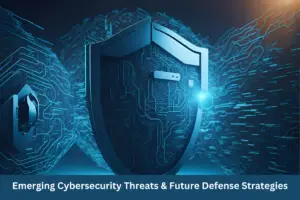Emerging Cybersecurity Threats & Future Defense Strategies
As technology continues to advance, so do the threats that target our digital world. Cybersecurity is now more crucial than ever, with attackers developing sophisticated methods to breach systems, steal data, and disrupt businesses. Understanding emerging cybersecurity threats and implementing effective defense strategies is vital to ensuring a secure future.
Emerging Cybersecurity Threats
1. Artificial Intelligence (AI)-Driven Cyber Attacks
AI is not only being used for cybersecurity defense but also by cybercriminals to automate attacks. AI-powered malware can adapt, evade detection, and exploit vulnerabilities more effectively than traditional threats.
2. Ransomware Evolution
Ransomware attacks have become more targeted and damaging. Attackers now employ double-extortion tactics, where they not only encrypt data but also threaten to leak sensitive information unless a ransom is paid.
3. Cloud Security Vulnerabilities
With businesses shifting to cloud computing, hackers are finding new ways to exploit misconfigurations, weak access controls, and insecure APIs, leading to data breaches and unauthorized access.
4. 5G Network Exploits
The rollout of 5G networks introduces new attack surfaces. Cybercriminals can exploit vulnerabilities in IoT devices connected to 5G networks, leading to large-scale cyber threats.
5. Deepfake and Social Engineering Attacks
Deepfake technology is being used to create convincing fake videos and voices, leading to fraud, misinformation, and identity theft. Social engineering tactics have also become more sophisticated, making it harder to detect phishing scams.
6. Supply Chain Attacks
Cybercriminals are targeting suppliers and third-party vendors to infiltrate larger organizations. By compromising a trusted partner, attackers can gain access to critical systems and data.
Future Defense Strategies
1. AI and Machine Learning for Cybersecurity
AI-driven security solutions can analyze vast amounts of data in real-time, detect unusual patterns, and respond to threats automatically. Machine learning models can help predict and prevent cyberattacks before they occur.
2. Zero Trust Security Model
Zero Trust is a security approach that assumes no entity (inside or outside the organization) can be trusted by default. It requires continuous authentication, strict access controls, and real-time monitoring to mitigate threats.
3. Advanced Threat Intelligence Sharing
Collaboration between organizations, governments, and cybersecurity firms is essential to share real-time threat intelligence. This collective approach can help detect and respond to emerging threats more effectively.
4. Blockchain for Cybersecurity
Blockchain technology can enhance security by providing decentralized and tamper-proof data storage. It can be used to secure transactions, protect identities, and prevent unauthorized access.
5. Biometric Authentication & Multi-Factor Authentication (MFA)
Traditional passwords are no longer sufficient. Implementing biometric authentication (fingerprints, facial recognition) along with MFA can enhance security and prevent unauthorized access.
6. Regular Security Audits & Employee Training
Organizations must conduct regular security assessments to identify vulnerabilities and strengthen defenses. Employee training on recognizing phishing emails, social engineering tactics, and safe browsing practices is crucial.
Conclusion
Cyber threats are continuously evolving, and organizations must stay ahead by implementing advanced defense strategies. By leveraging AI, Zero Trust models, threat intelligence, and blockchain, we can create a more secure digital future. Awareness and proactive measures are the keys to mitigating cybersecurity risks and protecting sensitive information in an increasingly connected world.






